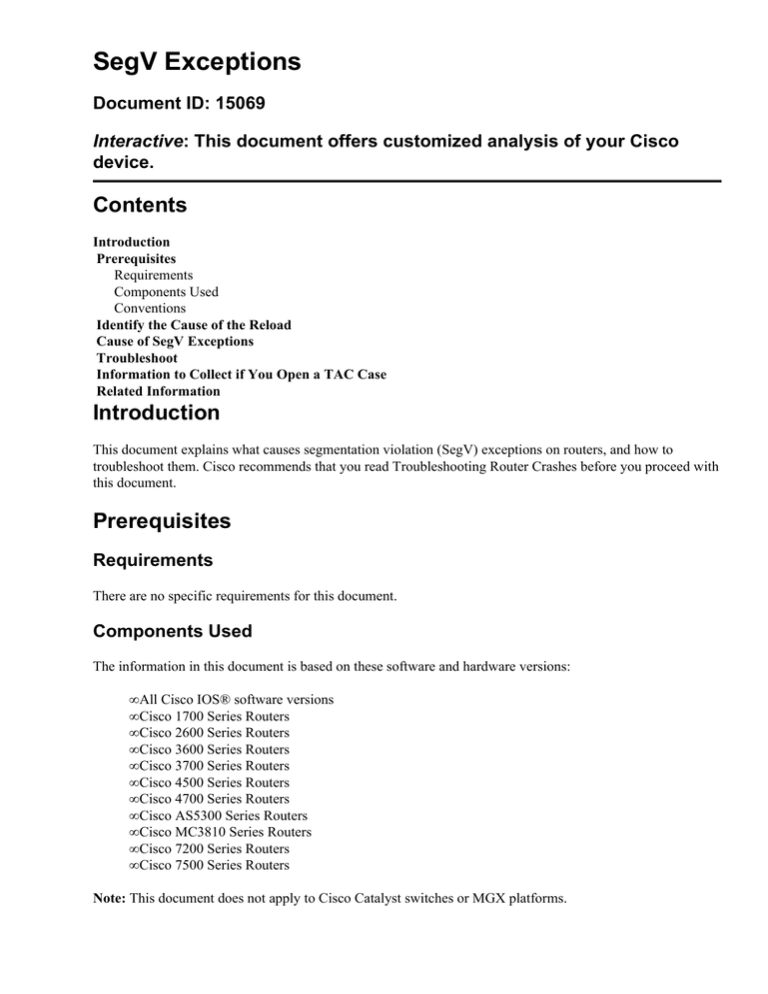
SegV Exceptions
Document ID: 15069
Interactive: This document offers customized analysis of your Cisco
device.
Contents
Introduction
Prerequisites
Requirements
Components Used
Conventions
Identify the Cause of the Reload
Cause of SegV Exceptions
Troubleshoot
Information to Collect if You Open a TAC Case
Related Information
Introduction
This document explains what causes segmentation violation (SegV) exceptions on routers, and how to
troubleshoot them. Cisco recommends that you read Troubleshooting Router Crashes before you proceed with
this document.
Prerequisites
Requirements
There are no specific requirements for this document.
Components Used
The information in this document is based on these software and hardware versions:
• All Cisco IOS® software versions
• Cisco 1700 Series Routers
• Cisco 2600 Series Routers
• Cisco 3600 Series Routers
• Cisco 3700 Series Routers
• Cisco 4500 Series Routers
• Cisco 4700 Series Routers
• Cisco AS5300 Series Routers
• Cisco MC3810 Series Routers
• Cisco 7200 Series Routers
• Cisco 7500 Series Routers
Note: This document does not apply to Cisco Catalyst switches or MGX platforms.
The information presented in this document was created from devices in a specific lab environment. All of the
devices used in this document started with a cleared (default) configuration. If your network is live, ensure
that you understand the potential impact of any command before you use it.
Conventions
For more information on document conventions, refer to the Cisco Technical Tips Conventions.
Identify the Cause of the Reload
If you do not power−cycle or manually reload the router, the show version output displays this:
Router uptime is 2 days, 3 hours, 5 minutes
System restarted by error − a SegV exception, PC 0x80245F7C
System image file is "flash:c2600−js−mz.120−9.bin"
or
Router uptime is 11 hours, 38 minutes
System returned to ROM by error − a SegV exception, PC 0x80249B0C
System image file is "flash:c2600−is−mz.121−1.5.bin"
These lines may also be present in the console logs:
*** System received a SegV exception ***
signal= 0xb, code= 0x1200, context= 0x80d15094
PC = 0x80678854, Vector = 0x1200, SP = 0x80fcf170
If you have the output of a show version command from your Cisco device, you can use to display potential
issues and fixes. To use, you must be a registered customer, be logged in, and have JavaScript enabled.
You can use the Output Interpreter (registered customers only) to display potential issues and fixes. To use the
Output Interpreter (registered customers only) , you must be a registered customer, be logged in, and have
JavaScript enabled.
Cause of SegV Exceptions
SegV exceptions are always software problems. It is possible for different software issues to cause a SegV
exception, such as:
• Access to an invalid memory address
• Write access to a read−only memory region
• A jump to an invalid PC (often 0x0)
Troubleshoot
If you have not manually reloaded or power−cycled the router since the SegV exception, you can search for a
known bug ID that matches the Output Interpreter tool.
If you have the output of a show stacks command from your Cisco device, you can use to display potential
issues and fixes. To use, you must be a registered customer, be logged in, and have JavaScript enabled.
You can use the Output Interpreter (registered customers only) to display potential issues and fixes. To use the
Output Interpreter (registered customers only) , you must be a registered customer, be logged in, and have
JavaScript enabled.
If the decoded output from the show stacks command matches a known software bug, you receive the bug
IDs of the most likely software bugs to have caused the SegV exception. Click on the bug ID hyperlinks to
view additional bug details from the Cisco Bug Toolkit (registered customers only) , which can help you
determine the correct bug ID match. Once you have identified a bug ID that matches, refer to the "fixed in"
field to determine the first Cisco IOS software version that contains the fix for the bug.
If you are uncertain which bug ID matches or which Cisco IOS software version contains the fix for the
problem, a Cisco IOS software upgrade to the latest version in your release train is one option that often
resolves the issue. This option often works because the latest version usually contains the fix for a large
number of bugs.
Information to Collect if You Open a TAC Case
If you still need assistance after following the
troubleshooting steps provided and want to create a service
request with Cisco Technical Support, be sure to include this
information:
• Steps performed to troubleshoot before you opened the
case.
• show technical−support output (if possible, in enable
mode)
• show log output or console captures if available
• crashinfo file (if present and not already included in
show technical−support)
You can upload this information to your case with the Case
Query tool (registered customers only) . If you cannot access the
Case Query tool, you can send the information in an email
attachment to attach@cisco.com with your case number in the
subject line of your message.
Note: Do not manually reload or power−cycle the router before
you collect this information unless required to troubleshoot a
SegV exception, as this can cause important information to be
lost that is needed in order to determine the root cause of the
problem.
Related Information
• Troubleshooting Router Crashes
• Technical Support − Cisco Systems
Contacts & Feedback | Help | Site Map
© 2014 − 2015 Cisco Systems, Inc. All rights reserved. Terms & Conditions | Privacy Statement | Cookie Policy | Trademarks of
Cisco Systems, Inc.
Updated: Jul 31, 2006
Document ID: 15069



